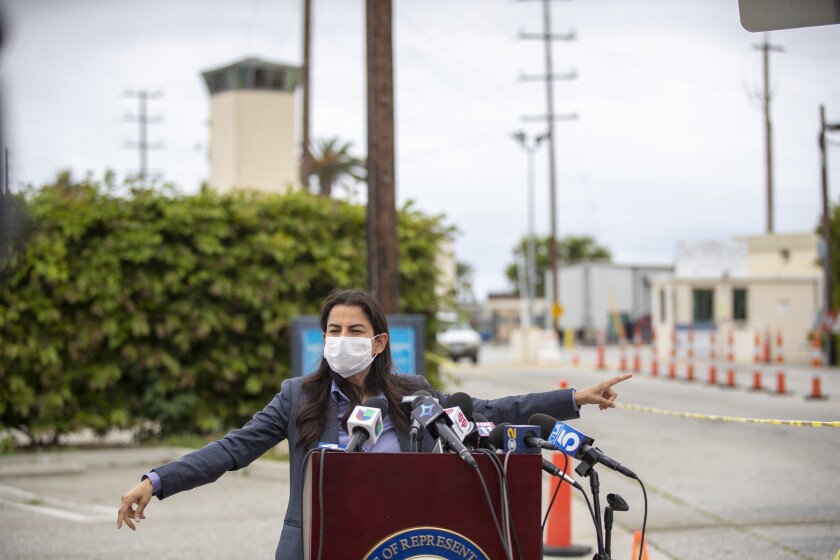Newsom pushes virus contact tracing with first batch of tracers
Vallejo Times-Herald, by Fiona Kelliher, May 24, 2020
A batch of about 500 people will be deployed this week statewide for contact tracing, the public health practice that involves tracking down people who have come in contact with COVID-19 patients.
Starting this week, the tracers will begin calling, texting and emailing those who may have been exposed to coronavirus, encouraging them to quarantine or recommending medical care, according to Gov. Gavin Newsom’s office. Meanwhile, Californians may notice new radio, television and billboard campaigns that aim to up awareness of contact tracing and urge people to pick up the phone. Tracers will be identified as part of the “CA COVID Team” — an effort led by the California Public Health Department — when texting or calling, and will not share health information with outside entities.
The tracers are the first batch toward a goal of 10,000 statewide, according to Newsom’s office. It’s not exactly clear how those tracers will work in tandem with local health departments’ own contact tracing programs.
Working with the University of California, San Francisco and Los Angeles, the state began developing an online training program earlier this month to get the tracers up to speed. Another 300 tracers will be trained this week, Newsom’s office said.
Governor Newsom Launches Contact Tracing Program
Gov Press Release,Governor asks Californians to answer the call to help keep our families and communities healthy and on the path to reopening
SACRAMENTO – In the ongoing efforts to mitigate the spread of COVID-19, Governor Gavin Newsom today launched California Connected, the state’s comprehensive contact tracing program and public awareness campaign. As part of California Connected, public health workers from communities across the state will connect with individuals who test positive for COVID-19 and work with them, and people they have been in close contact with, to ensure they have access to confidential testing, as well as medical care and other services to help prevent the spread of the virus.
The state’s program is led by the Administration in collaboration with the California Department of Public Health, local public health departments and the University of California, San Francisco (UCSF) and Los Angeles (UCLA), which have launched a robust online training academy to develop a culturally competent and skilled contact tracing workforce.
“We are all eager to get back to work and play, and that’s why we’re asking Californians to answer the call when they see their local public health department reaching out by phone, email or text,” said Governor Newsom. “That simple action of answering the call could save lives and help keep our families and communities healthy.”
To prevent the spread of this virus, public health workers will connect Californians with confidential testing. They may also recommend medical care,
and that individuals who could be infectious separate themselves from others in their home to protect those around them. Information provided to local public health departments is confidential under California law. Public health authorities will not share that information with outside entities. That information will be used for public health purposes only. Contact tracers will not ask for financial information, social security numbers or immigration status.
“A key step in stopping the spread of COVID-19 is quickly identifying and limiting new cases, across the diversity of our populations – and that’s exactly what this statewide program does,” said Dr. Sonia Angell, California Department of Public Health Director and State Health Officer. “We are bringing together the best minds in public health, academia and private industry to design a program that can help lower the risk for COVID-19 in all of our communities and keep us on the path to reopening.”
The California Connected public awareness campaign is getting off the ground this week with support from multiple private partners who have committed a total of $5.1 million in funding and in-kind resources to help educate all Californians, and underserved communities in particular. These partners include Jeff Skoll and his organizations (The Skoll Foundation, Participant, and Ending Pandemics), The California Health Care Foundation, The California Endowment, Twitter and Facebook, in addition to existing media partners engaged in the larger public awareness effort.
Beginning this week, Californians across the state will hear radio ads and see billboards, social media posts and videos in multiple languages encouraging them to answer the call to slow the spread of COVID-19. Public health workers across the state – identified on caller ID as the “CA COVID Team” – will call, text and email individuals who test positive for COVID-19 and people they may have unknowingly exposed to the virus.
The state plans to launch 10,000 contact tracers statewide as part of its plan to reopen California. More than 500 individuals have been trained under the new contact tracing program, and more than 300 are being trained this week.
To streamline and coordinate these efforts, Accenture, a leading global professional services company, is launching a data management platform developed by Salesforce and contact capabilities (phone calls, texts and emails) in collaboration with Amazon Web Service’s Amazon Connect. These organizations have already successfully implemented a large-scale contact tracing effort in Massachusetts.
More information: CaliforniaConnected.ca.gov.
A PSA from Director of the California Department of Public Health Dr. Sonia Angell can be found here. Watch the California Connected PSA in English here and in Spanish here. An infographic and other content can be found here.
Additional Resources:
[/su_column][/su_row]






You must be logged in to post a comment.